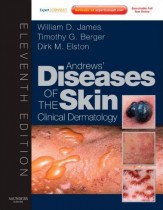You can become good to excellent at dermatology with the aid of no more than three books:
- Andrews’ Diseases of the Skin: Clinical Dermatology, 11e (2011): this book is king when it comes to a profoundly medicine-based understanding of dermatology. I seldom, if ever, recommend textbooks – and this one is more than 1210 pages long. You don’t have to read all of it, though. I would recommend, however, reading important topics in great depth. What are the important topics in dermatology? All of infectious diseases pretty much.

- Skin Disease: Diagnosis and Treatment, 3e (2011, reviewed here). This is a good general and introductory dermatology book. You won’t be wowed by the coolest pictures (for that you will need to see Fitzpatrick’s). The text is solid, however, without gimmicks and full of clinical pearls. It covers most of the important skin conditions that primary care doctors need to know. In some respects, the book is very much the “opposite” of Andrew’s, which is much more detailed and in-depth.
- Dermatology: Illustrated Study Guide and Comprehensive Board Review (2012): this is the finest dermatology review book around. It’s really rare for an individual author to display such an amazing depth and breadth of knowledge. This is the book that I would use to prepare for standardized testing in dermatology.
Now the proviso: no book can accurately depict what subtle skin lesions look like in real life, in patients with varied skin tones, stages, ages and lighting. Dermatology is not radiology. Pneumonia is always in the lung, but almost everything in dermatology can be made to look like something else when the lighting is off and the lesion is someplace else. Therefore, to become good at dermatology diagnosis, you will need to see a lot of skin pathology in real life. Unfortunately, I cannot help you with that (at the moment!). You need good clinical exposure and good mentorship. There’s no way around that.


Leave a Reply